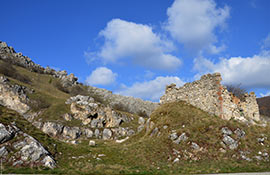The area of Forca Palena, located 1273 meters above sea level, corresponds to the part of the oldest settlement of the town of Palena. There is very little documented from the late middle ages but the geographer Diodor Siculo does give it a mention.
In the Middle Ages Forca Palena counted 25 dwellings which were housed within a defensive wall and was also place to the church of San Vito in Furca, assigned to the valvense Bishop Dodone in a letter by Pope Innocent II dated 25th March, 1138.
In 1268, following an asset division among the sons of the Earl of Palena, Thomas Vinciguerra, the young Florisenda received half of the Castle Forca. With this heritage the young girl fled to where she founded the monastery of Santa Chiara to which she donated all her possessions to. This is the reason why the area became known as "Quarto di Santa Chiara."
The quarrel between the Convent of St. Clare and the brothers of Florisenda was long and hard-fought with blows of notarial documents and letters. Later on also the University of Pescocostanzo let it known its intentions to acquire the property only to find itself in collision with the full force of the law and its legitimate owner, Palena.
On the 10th September, 1349, Nicolò was born in Forca Palena, the beatified monk who founded the small hermitage of Sant Onofrio on Gianicolo, where his remains are still today.
In October 1458 a meeting took place at Forca Palena between Antonio Caldora and Ferrante of Aragon, but in later years the peaceful meetings were replaced by hard armed clashes that saw confronts between the two house of Aragonesi and the Angioini.
In 1464 the Aragonese led by Ferrante and the Angioini led by Giovanni fought here, the battle was made even more gruesome by the use of fireballs. On the 3rd August, 1464 the Palenesi fought in the ranks of Ferrante and delivered the stronghold, in exchange for property, the battle lasted for three years: in 1467 Palena and its suburbs became part of the possessions of Matteo di Capua.

The area of Forca Palena, located 1273 meters above sea level, corresponds to the part of the oldest settlement of the town of Palena. There is very little documented from the late middle ages but the geographer Diodor Siculo does give it a mention.
In the Middle Ages Forca Palena counted 25 dwellings which were housed within a defensive wall and was also place to the church of San Vito in Furca, assigned to the valvense Bishop Dodone in a letter by Pope Innocent II dated 25th March, 1138.
In 1268, following an asset division among the sons of the Earl of Palena, Thomas Vinciguerra, the young Florisenda received half of the Castle Forca. With this heritage the young girl fled to where she founded the monastery of Santa Chiara to which she donated all her possessions to. This is the reason why the area became known as "Quarto di Santa Chiara."
The quarrel between the Convent of St. Clare and the brothers of Florisenda was long and hard-fought with blows of notarial documents and letters. Later on also the University of Pescocostanzo let it known its intentions to acquire the property only to find itself in collision with the full force of the law and its legitimate owner, Palena.
On the 10th September, 1349, Nicolò was born in Forca Palena, the beatified monk who founded the small hermitage of Sant Onofrio on Gianicolo, where his remains are still today.
In October 1458 a meeting took place at Forca Palena between Antonio Caldora and Ferrante of Aragon, but in later years the peaceful meetings were replaced by hard armed clashes that saw confronts between the two house of Aragonesi and the Angioini.
In 1464 the Aragonese led by Ferrante and the Angioini led by Giovanni fought here, the battle was made even more gruesome by the use of fireballs. On the 3rd August, 1464 the Palenesi fought in the ranks of Ferrante and delivered the stronghold, in exchange for property, the battle lasted for three years: in 1467 Palena and its suburbs became part of the possessions of Matteo di Capua.